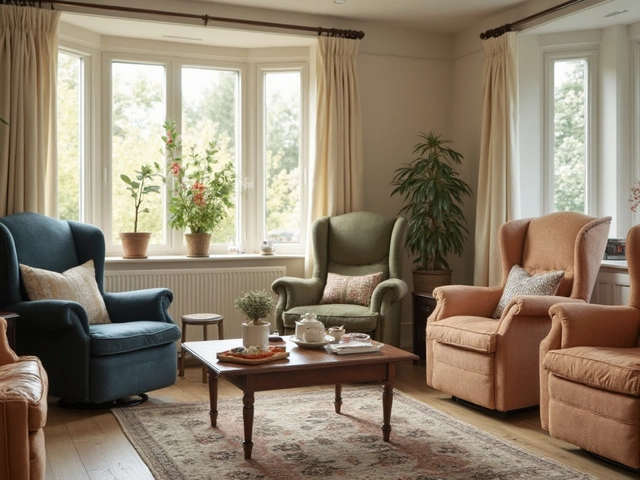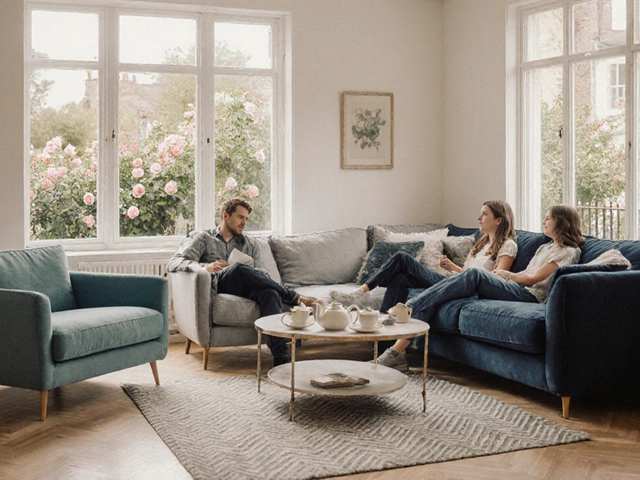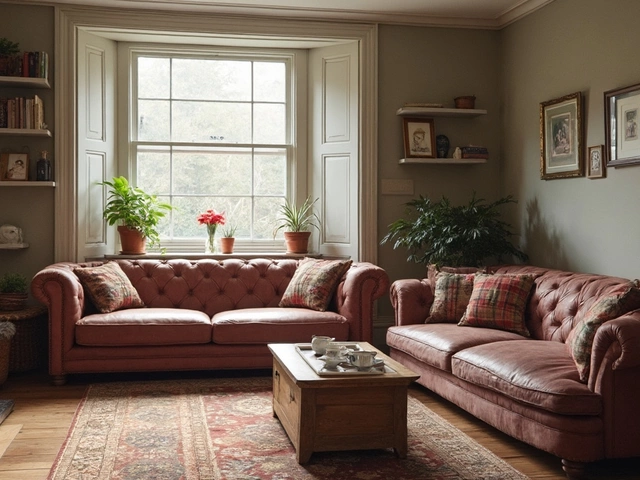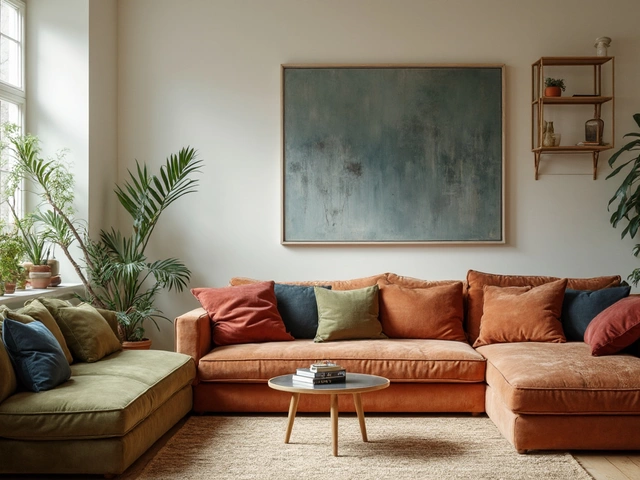 30
Jul,2025
30
Jul,2025
Ever tried to fold out a sofa bed and hit the coffee table—or worse, the wall? There’s nothing quite as frustrating as having nowhere to put the furniture you actually use. Yet sofa beds are a blessing when space is tight, or you often have overnight guests crashing at your place. So, where’s the magic spot for a sofa bed? Try moving it just once after a full set-up, and you’ll know it’s far from a fun game. We’re getting into the gritty, honest details of sofa bed placement. There are practical decisions, clever hacks, and more than a few gotchas nobody told me about until I learned the hard way. Ready to avoid bruised shins and make your space both inviting and liveable? Let’s get practical.
How Room Size Shapes Sofa Bed Placement
Room size is your starting point, like picking shoes that actually fit. You can’t squeeze a queen-size sofa bed into a shoebox apartment without some awkward corners—and bruised toes. In a smaller Melbourne flat (think: 40-60m²), you might only have a single good wall for a full-size pull-out. Measure from wall to wall, but don’t forget to measure with the sofa unfolded—it often extends up to two metres. Cutting it fine means you’ll have to rearrange furniture every time someone wants to sleep. Some people (my sister, for example) go for a loveseat-sized sofa bed for a tight home office or nursery. Smart, because it doubles as a reading spot or a guest bed for small children.
Another big thing people miss: in open-plan living rooms, sofa beds can define zones. Placing a sofa bed at right angles to your dining area can separate lounging space from eating space, giving you the illusion of a bigger and more organized room. But don’t push it right up against the wall if you haven’t got the clearance to open it up. Leave a little breathing space—around 30cm between the back of the sofa and the wall is a handy rule, so you don’t have to tug the whole thing forward when you need to use the bed.
For awkwardly shaped rooms—think L-shaped or oddly long studios—try placing the sofa bed near a window. The natural daylight makes the bed look more inviting, and you get a practical reading spot during the day. Still, don’t block airflow from windows or access to radiators and switches. In my house, I learned the hard way after blocking a heater vent: the guest ended up sweating buckets. Room size isn’t about just cramming things in, but letting everything breathe a bit.
And if you’ve got a monster-sized living area—lucky you—you have more freedom. You might put a large sofa bed in the center of the room to anchor the space, using a rug to provide a visual boundary. It can work as a divider, so you can have a separate play zone for kids on one side (Orla loves her craft corner), and a grownup lounge space on the other. Just make sure there’s still enough room to walk by comfortably when the bed is open.
Here's a handy table showing average open dimensions of common sofa bed sizes, measured in centimeters, helpful for planning:
| Sofa Bed Size | Closed Width | Closed Depth | Open Length (Bed) |
|---|---|---|---|
| Single | 85-100cm | 80-90cm | 200cm |
| Double | 120-160cm | 85-95cm | 200cm |
| Queen | 150-210cm | 85-100cm | 210cm |
Always check these figures against your floor plan—and never trust store displays, which usually look roomy but rarely show the bed unfolded.
Living Room, Spare Room, or Office? Choosing the Right Setting
Sofa beds aren’t just for guest rooms. In real-world homes, they do double duty anywhere, especially now, with so many people working or studying from home. The classic spot is the living room, but even there, there’s lots to consider. If your lounge is the room where you’re binging Netflix by night and transforming it into a bedroom by weekend, put the sofa bed where it faces the TV, but not so close that someone’s feet will knock over your console. Leave at least 90cm of space in front of the pull-out for walking when it’s open—otherwise you’ll be crawling over it, or your guest will get stuck.
For spare rooms, the sofa bed is a two-in-one winner. During most of the year, a sofa bed means you can use the room as a library, a craft nook, or a chill-out zone for the kids. I have a mate in Brunswick who uses her home office as a guest room too, with the sofa bed her dog claims most days. Multi-use matters more than you think—if your spare bedroom is tiny, pick a streamlined sofa bed with under-seat storage for bedsheets or pillows. Some even fold down from the wall or have built-in shelving units, getting even more use per square metre.
In studio apartments, the sofa bed often is the bed—period. So don’t be afraid to be bold and put it as the centerpiece. Get a bed-sized coffee table on soft wheels, so you can shift it aside easily at night. If you want to keep some sense of privacy for your sleeping area, try facing the back of the sofa bed towards the door and use a tall bookshelf as a room divider. That way, nobody’s walking straight into your bedroom when they enter. A folding screen works if you’re renting and don’t want to install heavy furniture. Melbourne rentals, especially in dense neighborhoods like Fitzroy or Carlton, often have weird nooks and very little storage, so furniture that multitasks is king.
Home offices are another rising trend: as of 2024, about 40% of Australians work remotely sometimes, according to the ABS. If you only have space for a desk and a small seating area, throw in a compact sofa bed for overnight guests. Just make sure you test the pull-out action—some cheap versions hit chairs or shelves that are too close by, which gets annoying fast. And always try before you buy; it’s easy to overlook the fact that when you’re working, you need enough natural light, but when a guest is sleeping, curtains or blinds are a must to keep out Melbourne’s early morning sun.
Pet owners: if you’ve got a cat or dog, pick a position away from food bowls or scratching posts, unless you want to replace the upholstery sooner rather than later. Leather can handle pet fur better, but it can scuff from claws. Washable slipcovers are always a win. For homes with younger kids, positioning the sofa bed near but not right inside the kids’ play area keeps bedtime separate from playtime—and less chance of waking a sleeping guest during early morning rush hour. The setting really shapes how the sofa bed works in your house, so don’t be afraid to move things around a few times before settling.

Sofa Bed Placement Do’s and Don’ts for Style and Function
For all their practicality, sofa beds can go from stylish centerpiece to awkward eyesore in the wrong spot. If you’re after both looks and practicality, here’s what you want to keep in mind:
- Sofa bed placement tip: never block pathways. High-traffic areas, like doorways and main walking routes, need to stay clear. Bumping into a corner in the dark isn’t just annoying—it can hurt.
- Natural light is your friend for daytime sofa use, but glare near TVs isn’t. If it faces direct sun in Melbourne summers, add light-filtering curtains that can slide behind the frame, so guests don’t wake up with the sunrise at 5:30am.
- Accent the area: rugs, ottomans, or a small table nearby make the sofa bed ‘zone’ look deliberate, not like an afterthought. But look for pieces that can be moved easily when you open the bed.
- Don’t sandwich the sofa bed between two walls or bulky furniture. Leave space for opening and closing drawers, closets, or window coverings. Move the TV, bookcase, or wardrobe if guests will need access to them when the bed is open.
- If your room is long and narrow, float the sofa bed away from the longest wall to create a cozier seating nook. You can always move it back at night.
- Low-arm or armless sofa beds offer more sleeping area and make the space feel less cramped, especially in smaller rooms.
- Try before you commit: mock up your room with masking tape on the floor to check how you’ll move around with the bed open. It takes just a few minutes and saves days of rearranging.
- Keep power outlets, lamps, and nightstands easy to reach. Guests will appreciate a spot to charge their phone or put a glass of water within arm’s reach.
- If you have to place the sofa bed in the middle of a room, anchor the back with a console table or a wide, low bookshelf. It makes the setup look intentional and provides storage.
- Embrace multifunctional furniture. Ottomans and coffee tables with storage, folding chairs, and wall-mounted shelves turn even a small setup into a powerhouse.
Watch out for one of the oldest mistakes: forgetting to leave space for sheets, pillows, and blankets storage. If your sofa bed is in a main living space with little closet room, go for a model with a deep under-frame drawer. Even a big basket nearby can do the job, but don’t let spare bedding clutter up the lounge. Another trick: keep a small lamp, a box of spare earplugs, and a set of water glasses close for guests. It just makes them feel welcome.
Always match the sofa bed’s style to your room. If you love Scandi minimalism, a sleek gray or beige fabric will blend right in, while bold colors or patterns work for fun, eclectic spaces. In cities like Melbourne, where homes can run the gamut from heritage terraces to glassy apartments, you can mix styles as long as the scale suits the room. Don’t be afraid to add bright cushions or throws—textiles are easy to update and give the space life.
Remember, the best sofa bed is the one you can actually use—regularly and comfortably. That only happens if it’s in a spot that works for your daily life, not just for the rare visitor. When picking your placement, think: would I sit here every day, or dread pulling it out? If it’s the latter, it’s probably time to try another corner.
Making the Most of Small Spaces with a Sofa Bed
Living small doesn’t mean settling for a less comfy or less stylish home. The right sofa bed can transform even the tiniest nook into a proper sleeping or chilling spot, if you’re clever with placement. As rental prices in Australia’s big cities went up nearly 7% last year (Domain data, winter 2024), more people are squeezing more life out of less room. Don’t shove a chunky three-seater into a single’s bedroom—it’ll just look out of place. Instead, pick sleek frames, slim legs, or modular designs specially made for city living.
One of my favorite Melbourne hacks: go vertical. Wall-mounted shelves or even a high storage unit above the sofa bed mean you’re not eating up extra floor space. Fold-down wall beds (yes, they still exist—hello, Murphy bed fans) are lifesavers in ultra-small rooms, flipping into a couch by day. In studios, nest small tables or stackable stools nearby, so you can rearrange on the fly. Look for sofa beds with built-in side tables, or place a rolling cart nearby to stash books, remote controls, and snacks that can double as a nightstand at bedtime.
Don’t ignore lighting. Use wall-mounted or flexible lamps, so you don’t have to sacrifice precious surface space for table lamps. Dimmable globes keep the vibe relaxed when the room doubles as a bedroom. Hidden strip lights under shelves create cozy mood and make it easier to navigate at night. Mirrors hung behind or beside the sofa bed can actually triple the sense of space, bouncing daylight around. In tiny rooms, every trick counts.
If you’ve got a little kid and only a tiny spare room, a single sofa bed plus a shelf full of books makes a brilliant playroom that turns into guest space at a moment’s notice. Or, in a larger living room, add a folding screen or curtain track that’s easy to pull closed—guests get privacy, and you keep the rest of the room looking tidy during the day.
Never overlook air flow: crowded small spaces get stuffy, especially if guests are using the bed more than a night or two. Place the sofa bed where a fan or open window can reach. Try to avoid cramming it between tall furniture that could block ventilation. If you use the sofa bed every night, pick a mattress with a good reputation for breathability and durability—memory foam can get hot, while innerspring types might last longer. A quick fact for Aussies: many modern sofa beds use pocket spring mattresses just like standard beds, so you don’t have to dread waking up with a sore back on Monday morning. Reviews from CHOICE magazine (2023) gave the nod to models with thicker, denser mattresses even in slim frames.
Getting the most from a small space isn’t just about furniture Tetris—it’s about thinking through your daily habits. Where do you want to sit and read? Where does your child play? How late does the sun hit this spot? Try living with your idea for a week, then swap things around if it’s not working. Convenience always wins: if you have to climb over something, move something every day, or fight clutter to use your sofa bed, you’ll just resent it. Put your comfort first, then tweak everything else to match. That’s how you turn even the smallest room into a winner with a sofa bed front and centre.




